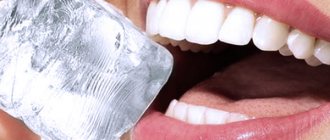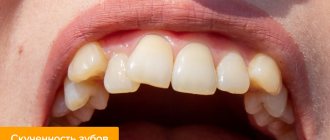Hyperesthesia is hypersensitivity of tooth enamel, manifested by short-term pain when exposed to external stimuli. Most often, symptoms are observed on the front teeth, which react painfully to biting, hot or cold. Increased sensitivity may manifest itself to sweet and sour foods, and discomfort occurs when brushing your teeth. Hyperesthesia must be combated, and the sooner treatment begins, the better. In advanced cases, the enamel is completely destroyed, and the affected teeth have to be removed. Let's try to figure out how to relieve increased sensitivity of teeth, what means are used for this, and how you can prevent the development of the disease.
Causes of high tooth sensitivity
Sensitive teeth
Modern dentistry distinguishes several classifications, and in the first place are carious lesions of the enamel and similar diseases:
- Medium and deep caries are irreversible destruction of the upper layers of dentin.
- Pulpitis is a complication of neglected or incompletely cured caries.
- Periodontitis and periodontal disease - due to extensive inflammation, the sensitivity of the enamel increases several times.
Non-carious factors include:
- Bruxism and malocclusion – with age, due to improper jaw position, the enamel becomes very thin.
- Wedge-shaped defect - destruction in the cervical area sooner or later leads to discomfort and aching pain.
- Demineralization due to poor nutrition, hormonal imbalance in the first trimester of pregnancy or old age.
- Chips, cracks and other tooth injuries.
In addition, there is a non-dental group of reasons:
- Serious diseases of the gastrointestinal tract.
- Endocrine disorders and diabetes mellitus.
- Bad habits – alcohol abuse and smoking.
High sensitivity can be local, when an individual tooth suffers, or generalized, in which the entire jaw needs diagnosis.
Types of hypersensitivity
The type of sensitivity depends on the location of the problem. Divided:
- Generalized. All or most teeth are affected. This is usually associated with a global problem such as pathological abrasion, periodontal disease and others.
- Localized. One or more teeth become sensitive. This can occur due to a violation of the integrity of the enamel, improper installation of the crown, or wedge-shaped defects.
The tooth may have visible defects - carious cavities, erosion, chips. If there is no visible damage, the sensitivity is most likely caused by chronic diseases.
Types of dental hypersensitivity
Causes of sensitive teeth
Today, patients often experience enamel sensitivity after whitening, both independently and in the dentist's office. To ensure that the aesthetic procedure does not cause discomfort, you need to remember important points:
- Whitening toothpaste has an abrasive effect, and it is not recommended to use it more than 2 times a week.
- Laser whitening and the ZOOM 4 machine are relatively safe methods, but they use a gel with carbamide peroxide, which often causes irritation.
- Kits with whitening compounds should be selected based on the jaw cast. If this is not possible, it is better to buy thermoplastic mouthguards.
Another case is sensitivity after installing a filling. At this point, the tooth “removes” after an anesthetic injection, and pain for 48 hours is normal. To minimize discomfort, the first two days you need to:
- Avoid hot tea and coffee.
- Avoid chewing gum and sweets.
- Chew food thoroughly, preferably without solids.
Enamel hypersensitivity in early pregnancy is associated with intoxication and hormonal changes in the female body. Here it is important to consult a dentist in time and consider a course of restorative therapy.
Why do teeth become sensitive?
Common causes of hypersensitivity:
Firstly, this is the abuse of whitening pastes. The fact is that such pastes contain silicon elements, which are designed to remove yellowed or darkened areas of enamel. Gradually, as a result of proper brushing, the tooth becomes whiter. But if you brush more often than the doctor prescribed or for a longer time, then the beneficial beauty properties of the paste become detrimental to tooth enamel and destroy calcium. As a result, the tooth “weakens” and begins to react painfully to irritants.
Secondly, it is the frequent consumption of foods that contain a lot of acid. These types of food include lemon, garlic, cucumber, yogurt, whey, pepper, avocado and many others. High acid content gradually leaches calcium from tooth enamel. Therefore, refrain from frequently consuming such foods, but rather, go for a check-up with a doctor and consult about your diet.
Thirdly, these are the consequences of mechanical damage to teeth. Injuries can occur during fights, at work, due to carelessness or negligence, during sports or service. Part of the tooth or filling breaks off, affecting the root and gums. This causes swelling, inflammation, or loosening of the tooth. As a result, when chewing food, a person feels discomfort.
Fourthly, this is periodontitis. The disease is characterized by inflammation of the soft tissues, which leads to the gradual separation of the tooth from the bone parts. The tooth gradually becomes loose and begins to cause discomfort to the person while eating. One of the hallmarks of periodontitis is bleeding gums. It is recommended to consult a doctor as soon as the first symptoms are noticed.
Fifthly, incorrect treatment. After a poor-quality filling, the tooth becomes sensitive if the doctor did his job improperly. During the treatment, the doctor may loosen the root or damage the enamel. As a result, the tooth begins to react painfully to irritants.
How to treat tooth sensitivity?
If the patient does not have caries or other pathologies, then enamel hyperesthesia is treated with an in-office remineralization procedure. It goes like this:
- The doctor removes accumulated plaque and tartar using ultrasound or an Air Flow device.
- The surface of the teeth is thoroughly dried and coated with a remineralizing composition.
- After 20-30 minutes, the remaining gel is cleaned off, and to improve the effect, a special varnish based on sodium fluoride is applied to the enamel.
The office procedure may not be enough, and then the doctor prescribes an additional course, which includes:
- Applications with Remodent suspension 3-4 times a day for 15 minutes.
- Applying Fluocal gel after morning brushing.
- Rinse with compositions containing 10% calcium gluconate.
A number of drugs “take root” better with the help of physiotherapy. Electrophoresis has proven itself well, when the active substance is attached to the gum on an electrode and catalyzed by microcurrents. This method will give additional tone and improve blood circulation.
How to relieve or soothe pain at home
While minor pain is easy to experience and even forget about, severe pain can seriously complicate life. What should you do if your teeth hurt very much after whitening, and an immediate visit to the clinic is impossible?
At home, you can relieve pain with fluoride toothpaste, but the fluoride content must be at least 1500 ppm. This paste has high remineralizing activity; it normalizes the mineral composition of the enamel, strengthens it and eliminates microdefects. But you should not abuse this remedy either.
The same method is useful when your teeth hurt after whitening with strips, which you definitely shouldn’t do - try to relieve the pain with cold or, on the contrary, with a warm compress. Pain after the strips indicates that the procedure was performed incorrectly. The strips with the active gel were overexposed, as a result the enamel was damaged, irritation occurred, and sensitivity increased.
Pastes and rinses with chamomile, calendula, sage, and propolis will have an analgesic effect. Extracts of these herbs have an antibacterial effect and eliminate inflammation.
What to do if you lose tooth enamel?
The problem is not always solved by remineralization and dental varnish. In cases where the enamel is worn out or severely cracked, gentle methods will not help. Modern dentistry offers several solutions with complete or partial preservation of the tooth:
- Veneers and lumineers are the most expensive method; they provide good protection, but do not restore chewing functions.
- Ceramic or zirconium crowns are strong and durable. Requires preliminary preparation of the support.
- Artistic restoration - new generation composite materials are practically indistinguishable from the natural shade, but last a maximum of 10 years.
Why does hyperesthesia occur?
The reason for this pathology lies in the influence of the following factors:
- Lack of balance in the menu, poor content of minerals and vitamins;
- Changes in hormonal levels;
- Long-term use of hormonal drugs;
- Past infectious diseases;
- Violations in the work of housing and communal services;
- Nervous disorders, stress;
- Malocclusion;
- Eating acidic foods in large quantities;
- Too hard toothbrushes;
- High abrasion of dental tissues;
- Unsuccessful attempts at teeth whitening;
- Wedge-shaped defects;
- Enamel erosion, periodontitis, caries;
- The habit of gnawing hard objects, grinding teeth;
- Smoking;
- Performed procedures for removing tartar.
To effectively solve the problem, it is important to correctly determine the cause of hyperesthesia. Tooth sensitivity can be relieved only after it has been eliminated.
PROMOTION
Inexpensive dentistry
Prices are 1.5-2 times lower
Prevention of tooth sensitivity
To preserve tooth enamel, just follow simple rules:
- Do not chew nut shells or similar hard foods.
- Chew food on both sides of the jaw alternately.
- Reduce the consumption of spicy, sour, salty and sweet foods in favor of fresh vegetables and fruits.
- Whiten your teeth no more than once a year.
- Avoid frequent injuries, falls and blows to the jaw area if you play contact sports.
- Treat caries and gum inflammation in a timely manner.
- Visit the dentist for a preventive examination at least 2 times a year.
Symptoms
Hypersensitivity mainly manifests itself in the form of short-term toothache or discomfort provoked by eating food of contrasting temperatures. The same sensations can appear when a person eats excessively sweet, salty, sour foods, and also simply carries out daily hygiene procedures. The pain can be mild or acute pulsating. The suffering does not last long, after a few seconds the condition returns to normal, the painful sensations disappear without a trace.
Manifestations can be local, affecting only one or a few dental elements, as well as generalized (when pain is felt in all of them at once, indicating the presence of caries, periodontitis or exposure of the necks and roots).
Pain is an integral part of hypersensitivity. Despite its temporary disappearance and the absence of concern when eating hot, cold, salty, sour and sweet, the problem does not solve itself. Remission periods are simply observed periodically. The pathology will not go away, the condition will only worsen if you do not promptly use the help of a competent dentist.
How to avoid hyperesthesia after therapeutic treatment
When solving the problem of tooth sensitivity, it is worth distinguishing between pain caused by errors in different treatment methods and temporary sensations after caries treatment.
When treating living teeth, a temporary sensitivity effect may occur as a result of treating the enamel around the defect with acid to securely fix the filling. In the process of leaching out calcium, the enamel area becomes porous, more accessible to irritants of the nerve endings of the tooth located in the dentin.
After the necessary treatment in a clinical setting, the surface of the teeth is treated with two-component preparations to remineralize it with calcium and subsequent fluoridation to form strong compounds that are resistant to acids.
Choosing the appropriate method for strengthening enamel
When wondering which method to choose, don’t make the decision on your own. Home methods for remineralizing tooth enamel are effective only at the initial stage of enamel destruction. If demineralization has affected the deep layers, then only professional help from a dentist can stop the process. Therefore, it is better to seek the advice of a specialist before purchasing a specific enamel strengthening product.
In addition, in some cases, the dentist may recommend complex therapy: a combination of home dental care with remineralization in the clinic. In this case, the doctor will select for you both suitable products for independent use and professional procedures.
Restoring the mineral composition of teeth is the first and very important step to oral health. It is important to notice the problem in time and contact a specialist, then it will be possible to choose the right course of treatment, stop the carious process, reduce the sensitivity of the teeth and protect them from destruction.
Preventive actions
Even the most gentle teeth whitening involves a demineralizing effect on the enamel and, accordingly, this process increases its permeability and irritability. To alleviate the condition and reduce the feeling of discomfort after the whitening procedure, you should follow the basic rules of prevention:
- Do not drink too cold or hot drinks or foods in the first 1-2 days after the procedure. Room temperature for food and drinks is considered optimal;
- exclude acidic foods from the diet;
- avoid chemical or thermal effects on tooth enamel;
- To brush your teeth, use a brush with soft bristles, which does not irritate the enamel coating when in contact;
- You cannot brush your teeth immediately after the whitening procedure; you need to wait several hours. When brushing, movements should be light and circular; in no case should you press on the surface of the teeth.
To quickly and effectively restore enamel after lightening, dentists recommend rinsing your mouth with special lotions with a high fluoride content. Such liquids reduce sensitivity and nourish dental tissues with minerals.
You should not whiten sensitive teeth yourself without first consulting a qualified professional. Such actions increase the risk of even greater enamel irritation and can lead to lengthy and complex treatment.
Contraindications
Both professional and home whitening of sensitive teeth is contraindicated in the following cases:
- if there are cracks or chips in the enamel;
- with carious damage to teeth;
- if the seal fits poorly, whitening will only increase tooth sensitivity;
- if you are allergic to bleaching components and in particular to hydrogen peroxide;
- for periodontal disease and other types of dental diseases.
A relative contraindication is pregnancy and breastfeeding. Such procedures are prohibited for children and adolescents under 16 years of age.










